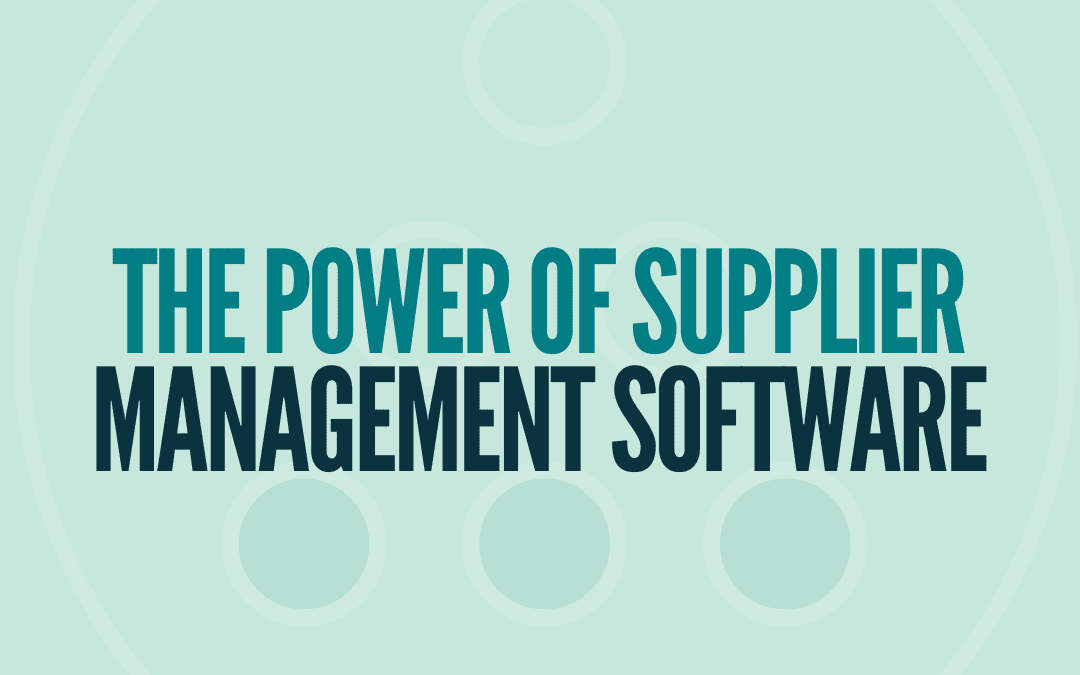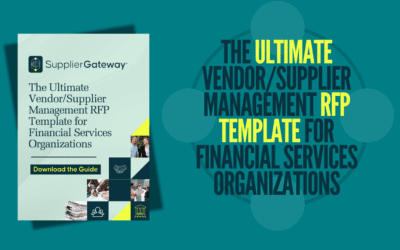The word optimization gets thrown around a lot when talking about supply chain management but what does it really mean for your business?
Consider the manual and time-consuming tasks your current vendor management system involves. Do you find it challenging to maintain consistent communications with suppliers? How much visibility and control do you really have on spending? How does human error affect accuracy and efficiency?
If you’re still drowning in spreadsheets and responding to supply chain issues as they arise, learn how to transition to a more proactive approach by incorporating five key strategies for supplier optimization.
What is supplier optimization?
While supply chain optimization involves all aspects of the supply chain, supplier optimization focuses on improving the efficiency and effectiveness of relationships with individual suppliers. Broadly, it centers around:
- Selecting the right suppliers
- Managing supplier relationships
- Improving communication and collaboration
- Optimizing sourcing processes
- Ensuring the quality and reliability of goods or services
It’s an ongoing, essential process for maximizing the value derived from supplier partnerships and enhancing the overall performance of the supply chain.
Challenges of Ineffective Supplier Management
Without structured optimization processes, businesses open themselves up to operational inefficiencies, increased costs, and risks within their supply chains. Common challenges include:
- Ineffective manual processes lead to disorganized sourcing, ordering, and managing supplier relationships, wasting time and resources.
- Lack of visibility and control results in difficulties tracking spending patterns, monitoring performance metrics, and identifying areas for improvement, which influences decision-making.
- Communication challenges cause misunderstandings and delays in the procurement process, impacting productivity and collaboration.
- Lack of diversification creates a dependency on a small number of suppliers, increasing the risk of disruptions and limiting opportunities for innovation and competitiveness.
- Onboarding and offboarding difficulties delay onboarding, complicate terminating relationships, and reduce operational agility and responsiveness.
Unstructured, manual processes lead to reactive supply chain optimization techniques, meaning you’re constantly operating in crisis mode. In contrast, supplier optimization develops a proactive approach that anticipates and addresses potential issues before they escalate – minimizing costs, improving operational resilience, and mitigating risks.
Benefits of a Supplier Optimization Process
A recent study by Boston Consulting Group (BCG) found that the top concern for companies worldwide is cost management, with 65% specifically focused on supply chains and manufacturing. Supplier optimization addresses this concern by producing cost-focused benefits like:
- Cost savings: Reduce administrative overheads and negotiate better pricing terms with suppliers through bulk purchasing or long-term contracts resulting in direct cost savings and improved profitability.
- Enhanced cash flow management: Streamline procurement, negotiate favorable terms, and implement efficient inventory management practices to reduce costs and free up cash that would otherwise be tied up in excess inventory or inefficient purchasing practices.
- Total Cost of Ownership (TCO) Analysis: Conduct comprehensive TCO analyses, considering not only the initial purchase price but also factors such as maintenance, support, and disposal costs for better-informed decision-making.
The benefits of supplier optimization extend beyond financial gains, delivering less quantifiable advantages like:
- Reduced risk: Mitigate risks associated with supplier dependency, supply chain disruptions, and quality issues by diversifying the supplier base, implementing risk management strategies, and monitoring supplier performance closely.
- Better innovation: Leverage supplier expertise, insights, and resources to drive innovation, enhance product quality, and gain a competitive edge in the market.
- Enhanced visibility: Centralize supplier data and streamline communication channels through source-to-contract software to access real-time information about supplier qualifications, performance, and quality metrics.
Combined, these benefits directly address the challenges of ineffective vendor management, ultimately contributing to improved operational productivity, competitiveness, and adaptability.
5 Key Strategies for Successful Supplier Optimization
Together with supplier management software, these key strategies contribute to the development of robust, adaptable supplier management processes.
1. Dynamic Spend Analysis for Informed Decision-Making
Spend analysis pinpoints cost-saving opportunities and guides procurement decisions. Businesses can easily identify areas for negotiation, consolidation, and optimization by analyzing spending patterns across suppliers.
This data-driven approach enables informed decisions on supplier selection, contract negotiations, and inventory management, reducing costs and improving profitability.
2. Centralized Supplier Data for Strategic Insights
Centralized supplier data offers strategic insights into supplier performance, spending, and relationships. It also facilitates key performance indicators (KPIs) tracking to identify opportunities for optimization.
For example, you might use a Supplier Management Platform to identify top-performing suppliers for preferred partnerships, negotiate volume discounts, or consolidate spend to leverage better pricing.
Having all of your supplier information in one place means you can make data-driven decisions to streamline operations and drive cost savings.
3. Supplier Relationship Management (SRM): Building Strategic Partnerships
Supplier Relationship Management (SRM) fosters strategic partnerships through effective communication and collaboration.
Regular meetings and performance reviews help align goals and expectations while collaborative initiatives, like joint product development, enhance innovation and market competitiveness.
By nurturing transparent and collaborative relationships, SRM strengthens ties with suppliers, fostering mutual success, trust, and long-term sustainability.
4. Strategic Supplier Diversification for Resilience
Spreading risk across multiple partners makes businesses more adaptable to changing market conditions, ensures continuity of supply, and safeguards against unforeseen disruptions.
Diverse suppliers, easily sourced through supplier diversity management software, also offer alternative expertise, unique insights, and market access, fostering innovation and competitiveness.
5. Streamlining Onboarding and Offboarding Processes
Businesses thrive on smooth transitions and suffer when disruptions occur. Optimizing vendor onboarding and offboarding ensures processes run smoothly.
For instance, supplier and vendor onboarding software simplifies vendor qualifications, creates contract protocols, acts as a single source of information, and mitigates legal risks.
Solutions with robust offboarding processes can also help maintain operational continuity through seamless knowledge transfer, data protection, and orderly contract closures.
Leveraging Technology: The Power of Supplier Management Software
Leveraging management software revolutionizes supply chain optimization optimization. SupplierGateway supports these efforts by streamlining supplier management processes from start to finish.
Seamlessly source, connect with, and onboard diverse suppliers through our intuitive, user-friendly platform.











